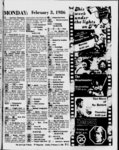| OCR Text |
Show Why there should be a joint U.S. Soviet expedition beginningin 1992 I N THE DARKENED TbeauMtiaa auditorium of the National Academy of Sciences in Washington, D.C., the five of them veterans of many 1976 space missions reminisced ta about the silent movie being lyVttvl.a projected on the big front Hiacacraft fra Earth. screen. With an easy, humor, they de- Vikiag's scribed the design of the compatible docking module, the separate launches from Cape Canaveral, Fla., and Tyuratam in the USSR, the dangerous rendezvous , the triumphant era wling through the air locks to visit one another, the exchange of gifts, the camaraderie and their separate returns to Earth. Occasionally, a little shyly, they would put an arm around each other. Many in the audience were struck by the mutual affection and respect of Lt. Gen. Thomas Stafford, U.S. Air Force, former commander at Edwards Air Force Base, where aircraft are tested, and Maj. Gen. Alexei Leonov, Soviet Air Force, the first human to walk in space. As the film ended and the lights came on, there arose from the sedate audience of engineers and scientists a sound 1 have rarely heard an ovation of such a timbre and intensity that you knew something deeply felt had been touched in that hard-bittand tough-mindaudience. Maybe it was possible after all, you got to thinking. Maybe these two nations could work together in their common interest. Perhaps they could set aside a little of the mutual paranoia and propaganda, to say nothing of their 55,000 nuclear weapons'. Weve been conditioned to think that in the real world it could never happen, that its too good to be true. But it had happened in World War II, against a common enemy, and in a small way it had happened in July 1975, with the ApolloSoyuz linkup that we were celebrating. That linkup, 1 knew, had its genesis, in large part, in an idea proposed by PARADE back in January 1966. Affirming in an open letter to President Lyndon Johnson that space should be a territory for peaceful exploration, not a battleground, PARADE proposed that an American astronaut and a Russian cosmonaut orbit the Earth together in a two-ma- n capsule a demonstration of superpower cooperation that would transcend political differences. The response at the time from readers and newspaper editors alike was overwhelmingly positive. Six years later, in May 1972, President Nixon and Premier Kosygin signed an agreement providing for U.S. -- Soviet cooperation in exploring space for peaceful purposes, leading to self-mocki- en ed CIA LK EHOTIX.RAPH BY STEVE SMITH the 1975 ApolloSoyuz linkup. Now, here they were, the veterans of that contact between alien civilizations, describing a mission whose accomplishment, apart from some worthwhile science, were chiefly in the cause of human understanding. There was a hunger in that audience as there is throughout the world a longing for the two nations to do something together for a change, something on behalf of the human species. Our powers are so great and our accomplishments so feeble. Think of what we could do together. As the five astronauts and cosmonauts were given relief maps of the Kasei Vallis region of Mars, you heard another stirring ovation, and again the thought arose unbidden: Maybe it was possible after all. Mars is the world next door, the nearest planet on which an astronaut or cosmonaut could safely land. Although it is sometimes as warm as a New England October, Mars is a chilly place, so cold that some of its thin carbon dioxide atmosphere freezes out at the winter pole. There are pink skies, fields of boulders, sand dunes, vast extinct volcanos that dwarf anything on Earth, a great canyon that would cross most of the United States, sandstorms that sometimes reach half the speed of sound, strange bright and dark markings on the surface, mountains shaped like pyramids and other enigmas. Among these many wonders and delights are the channels. The surface of Mars is covered with hun dreds of ancient river valleys, carved out in a more clement time when liquid water flowed across the martian landscape. Not only were there rivers then, but also lakes and (possibly) oceans. When, in 1976, the two Viking landers set down on Mars, no sign of life was uncovered no footprints, no artifacts, no trees or bushes or desert coneys or microbes, not even so much as a complex organic molecule. Mars seems to be lifeless today. But what seems certain is that a billion years ago, when the waters flowed, the chances of life were much greater on that wetter and wanner Mars. If we could wander down one of the sinuous valleys and examine the geological stratifications in the banks, we might discover much about climate change and the origin and evolution of life, and about the comparative developments of sister worlds. Mars beckons, a storehouse of scientific information important in its own right but also for the light it may cast on the environment of our own planet. If Mars once had abundant liquid water, what went wrong? How did an Earthlike world become so parched, frigid and comparatively airless? Is there something here we should know about our own planet? We humans have been this way before. Christopher Columbus would have understood the call of Mars. But mere scientific exploration does not require a human presence. We can always send smart robots. They are much cheaper, and you can take more risks with them. PMC 4 FEMUMY 2, 19M PMAOC MMAZMC |





































































































































































































































